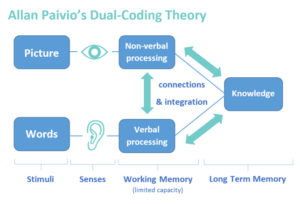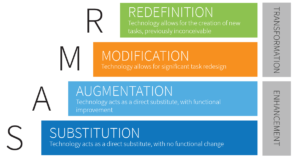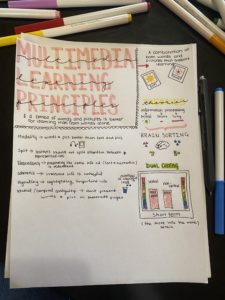Our learning pod decided to remix Chapter 19 from The Cambridge Handbook of Multimedia Learning : “The Feedback Principle in Multimedia Learning” (Mayer, 2014). The authors, Johnson and Priest, suggest that “students learn better with explanatory feedback than with corrective feedback alone” (2014. p. 449). Explanatory feedback can be described as a “principle-based explanation of why [the] answer is correct or incorrect” (Johnson, Priest. 2014. p. 450). Opposingly, corrective feedback refers to feedback that only informs the learner on the correctness of their answer. The article includes various research studies and there is significant data that supports the theory that explanatory feedback offers students a more enriched learning experience. Continuing on, feedback needs to be presented in accordance with the other Multimedia Principles in order for it to be effective. We all were interested to learn about the potential drawbacks of excessive explanatory feedback. The authors share that although explanatory feedback is more beneficial for novice students, sometimes advanced students will benefit from corrective feedback.
The feedback principle is based on the Cognitive Theory of Multimedia Learning (CTML) (Johnson, Priest. 2014. p. 450). In the CTML there are three assumptions made on how learners process information. Two of which closely overlap with the dual coding theory. The assumptions are: there are separate channels for verbal and visual information processing and each processing channel is limited in the amount of information it can receive (Johnson, Priest. 2014. p. 450). These concepts are explained almost identically in Mahon’s Vimeo on dual coding theory. However, Mahon goes into further detail and explains that when similar information is stored in both verbal and visual channels, the information recall is much better than if it were stored in only one channel. This occurs because when similar information is received in two forms it “reduce[s] any cognitive load” therefore, limiting the amount of stress on the working memory (Johns. 2019).

Retrieved from: https://sciencetltoolkit.wordpress.com/2019/03/11/20-ideas-strategies-for-student-led-dual-coding/ by Tom Johns
Another key aspect of the feedback principle is that it should “prompt active processing” (Johnson, Priest. 2014. p. 455). According to the CTML there are three types of processing which occur during learning: generative processing, essential processing, and extraneous processing. When feedback is effective it allows the student to engage in generative processing which is a form of processing that is “aimed at making sense of the essential material” (Johnson, Priest. 2014. p. 451). When feedback is given poorly, it can send the learner into extraneous processing. Extraneous processing is defined as a type of cognitive processing “that occurs as a result of poor instructional design that does not serve the educational goal” (Johnson, Priest. 2014. p. 450). This form of processing can overwhelm the learner as they “must figure out why the answer was wrong” (Johnson, Priest. 2014. p. 451). Lowered learning outcomes can be a result of extraneous learning as it limits learners’ cognitive resources. (Johnson, Priest. 2014. p. 451). Emphasizing the importance of quality feedback that encourages generative processing.
When one is delivering feedback, it can be given in one of two forms, explanatory or corrective. As stated before, both forms inform the learner whether their responses were correct or incorrect; however corrective feedback simply states whether the answer given was right or wrong while explanatory feedback offers the learner a reasoning behind why their response was considered correct or incorrect (Johnson, Priest. 2014. p. 450). Having the opportunity to deliver explanatory feedback allows learners to engage in generative processing. When questions are delivered to students to measure their understanding, they are generally aimed toward understanding essential information. If explanatory feedback is given following these questions, students receive further reasoning behind the outcome of the response and may develop more clarity of the essential information needed to understand the concept being learned. As explanatory feedback aims to provide clarity and understanding of information, it relates closely to the signalling principle presented in Mayer’s Principles of Multimedia Learning.
The signaling principle suggests that students are able to develop a deeper understanding of information delivered within a multimedia presentation when “cues are added that guide attention to the relevant elements of the material or highlight the organization of the essential material (van Gog. 2014. p.263.)” Explanatory feedback can be used to highlight the essential information and help students further understand the key elements of a concept; therefore, it fulfills the criteria presented by the signaling principle. As explanatory feedback is given, it enables learners to select the appropriate and relevant information needed and furthermore, “allow[s] the learner to repair their knowledge at that moment (Johnson, Priest. 2014. p. 451.)”
Ultimately, explanatory and corrective feedback can be related to both types of assessment: summative and formative. Explanatory feedback encourages students to expand their learning and focus on the process; just like formative assessment does. However, when students are being assessed on the terms of right or wrong, they are likely to rush through in order just to get the correct answer. Unfortunately this means they are missing out on the importance of problem solving and falling into a pattern of rote learning; similarly, this can be seen when using summative assessment such as standardized testing. Ultimately, it is up to educators to choose whether explanatory or corrective feedback will create a classroom that values the learning process over the final product.
We created a Kahoot to demonstrate what corrective feedback looks like. When playing the game, students will receive a quick yes or no in response to their answer. This can be very challenging for students when they are trying to solidify facts and knowledge. With that being said, corrective feedback can be helpful in certain scenarios and Kahoot is definitely a fun way to engage students!
We concluded that FreshGrade is the best platform to support students through active and constant feedback. Explanatory feedback is taken to the next level when FreshGrade is brought into the picture because it involves students, parents and the educator. Take a look at how Fresh Grade is currently being used in British Columbian classrooms!
McFadzien states that “effective feedback” should be “specific, descriptive, [and] time appropriate” (2015, p.16). Additionally, we know that feedback is crucial in terms of the development of our students. Furthermore, instead of only providing students with feedback twice a year on their report card, FreshGrade continuously allows students to see what they are doing well, where they need improvement and the best part is that it is all in one place so the students’ progress is extremely evident.
In conclusion, after reading the feedback principle chapter we were better able to understand how it relates to all of the multimedia principles from Mayer’s textbook. Finally, we all took a chance to reflect on our teaching practices and reconsidered how we will provide students with feedback in our future classrooms.
Kate, Carly, and Natalie
References:
FreshGrade. (2018, April 2). FreshGrade: Coquitlam School District’s Story. Youtube. Retrieved from: https://www.youtube.com/watch?time_continue=148&v=73GjK71JEhY&feature=emb_logo
Johns, Tom. (2019, March 11.) 20 ideas & strategies for Student Led Dual Coding. Teaching and Learning Toolbox for Student Led Dual Coding. Retrieved from: https://sciencetltoolkit.wordpress.com/2019/03/11/20-ideas-strategies-for-student-led-dual-coding/
Johnson, C., & Priest, H. (2014). The Feedback Principle in Multimedia Learning. In R. Mayer (Ed.), The Cambridge Handbook of Multimedia Learning (Cambridge Handbooks in Psychology, pp. 449-463). Cambridge: Cambridge University Press. doi:10.1017/CBO9781139547369.023
Mayor, R. E. (August, 2014). The Cambridge Handbook of Multimedia Learning. Cambridge: Cambridge University Press. doi:10.1017/CBO9781139547369.
McFadzien, N. (2015) Why is effective feedback so critical in teaching and learning? Journal of Initial Teacher Inquiry, (pp. 469-481). Retrieved from: https://pdfs.semanticscholar.org/989f/ad2627f5f7b0269c5db249baa96b5bd5e8ef.pdf
Van Gog, T. (2014). The Signaling (or Cueing) Principle in Multimedia Learning. In R. Mayer (Ed.), The Cambridge Handbook of Multimedia Learning (Cambridge Handbooks in Psychology, pp. 263-278). Cambridge: Cambridge University Press. doi:10.1017/CBO9781139547369.014
Kahoot!. Retrieved from: https://create.kahoot.it/share/types-of-animals/b39ecab7-fc34-4b4f-969a-828a96d938ec






